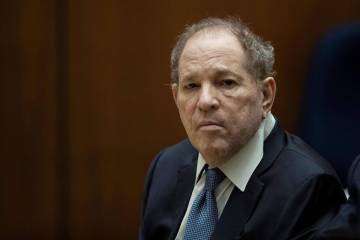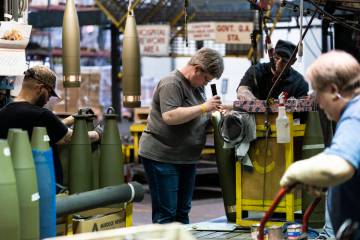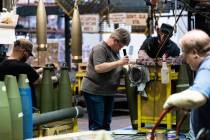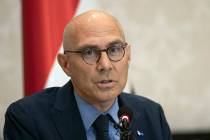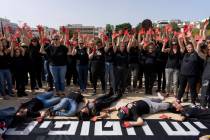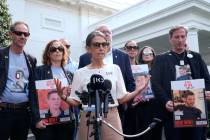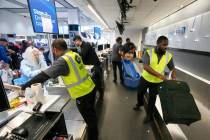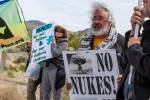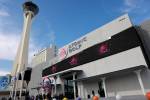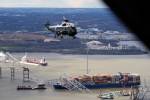Atomic town revels in past despite tunnel collapse sparking fears
RICHLAND, Wash. — This town at the edge of the Hanford nuclear site long ago made its peace with the facility’s history of producing plutonium for nuclear bombs.
Bomber’s Drive-Thru sells milkshakes and burgers. The Richland High School mascot is the Bomber, and a mushroom cloud is painted across the gymnasium floor. There’s Atomic Bowl, Atomic Foods, Atomic Auto Body, Atomic Scuba.
The Atomic Ale Brewpub & Eatery’s menu highlights a “Reactor Core pizza” with “nuclear butter” and sells house-made beers like “Half-Life Hefeweizen” and “Oppenheimer Oatmeal Stout.”
Hours after the collapse of a 20-foot portion of a Hanford tunnel full of highly contaminated equipment, Adrian Martens was sitting at the bar having a pint after his Tuesday shift. He said people here aren’t afraid of Hanford — or adopting the atomic iconography as kitsch. “It’s a fun retro thing,” he said. He thinks the news panicking about the tunnel collapse “might be overblown.”
What isn’t overblown is the $6.1 billion annual cost of cleaning up the highly dangerous material at Hanford and the nation’s other former nuclear weapons sites, vestiges of the Cold War-era arms race. The Energy Department has cleaned up 91 of these sites but is still working on 16 others, including complexes at Oak Ridge in Tennessee and Savannah River in South Carolina.
Hanford is the biggest. The cleanup there started in 1989, and federal and state officials recently agreed to push back the deadline for finishing the job. The Hanford effort alone will cost $2.3 billion this year, and as much as $105 billion in the future, according to a 2016 life-cycle report.
Some nuclear experts said that the collapse of the tunnel Tuesday morning was evidence of faltering infrastructure at the sprawling 580-square-mile Hanford site as the federal government battles to clean up nuclear material, in both solid and liquid forms, that remains there. The tunnel, built a half-century ago with Douglas fir timbers and sealed shut years ago, did not stay closed, exposing contaminated rail cars and other debris to the open air.
“Hanford overall is the most contaminated site in North America, and the facility near where the tunnel collapsed today is one of the most contaminated facilities at Hanford,” said Dan Serres, conservation director of the Columbia Riverkeeper.
News from the Hanford site Wednesday was limited. The Energy Department said that no contamination has been detected following the cave-in. But it also ordered nonessential employees in part of the site to stay home.
Crews worked through the night to construct a gravel road, and workers wearing protective suits and breathing masks started filling the gaping hole with about 50 truckloads of soil.
Edwin Lyman, a senior scientist at the Union of Concerned Scientists, said that if there were a significant release, the radioactivity in the tunnels would make it extremely difficult for workers to continue to monitor the site and carry out cleanup efforts.
Gerry Pollet, executive director of Heart of America Northwest, a watchdog group for the Hanford cleanup, said the site is vulnerable to natural disasters and that the collapse this week is worrisome because it could mean there are other weaknesses: “If you have a partial collapse right now, obviously the integrity of the tunnel is in question for more than just the part that collapsed.”
The Hanford nuclear site, half the size of Rhode Island, was placed in a far-flung, desolate southeast corner of Washington state, a far cry from the lush green forests and mountains that define the northwestern United States. It’s dry and hot here: a patchwork desert that gets little rain but that commands its own unique beauty. When the sun sets here, it boils under a flat black horizon, painting the wide sky in oranges and greens.
The city of Richland largely popped out of the desert during World War II to house the influx of scientists and workers employed at the Manhattan Project site. The plutonium produced at Hanford filled the Fat Man nuclear bomb, which was dropped over Nagasaki, Japan, killing tens of thousands of people.
Today, Richland, Kennewick and Pasco — known as the Tri-Cities — still have a bit of a children’s pop-up book feel: identical-looking houses with bright green lawns and gleaming white fences that sprout out of the desert landscape suddenly and harshly.
Libby Horton, who now lives in Boulder, Colorado, was back in her hometown of Richland eating pizza at Atomic Ale this week. She shakes her head at the idea of being afraid of some kind of nuclear disaster at Hanford. Her parents both worked there.
“People are more educated here about what goes on at the site,” she said, noting that she’s not bothered at all by Tuesday’s tunnel collapse. “My friends on Facebook are laughing about it.”
Tracy Lugo, a second-grade teacher, said his school did more drills and training in preparation for a potential leak at the Umatilla Chemical Depot, south of the Tri-Cities in Hermiston, Ore., where the U.S. Army stored chemical weapons until 2011. He doesn’t fear a meltdown or leak at Hanford.
“I’m more concerned about Kim Jong-Un dropping a nuclear bomb on us in the next couple of years,” he said. Lugo’s 13-year-old daughter, Celia, piped up on a point of pride about living in Richland: It’s easier to earn the Girl Scouts’ “Get to Know Nuclear” merit badge, which allows scouts to visit a nuclear plant.
“You learn about how nuclear energy works,” Celia said. “And wear hazmat suits.”
Some academic experts agree that risks related to Hanford are small because any radiation leak from the site would dissipate before it affected nearby towns. “The risk, if people are exposed at low levels, is primarily radiation-induced cancer at some point in the future,” said David Brenner, director of the Center for Radiological Research at Columbia University. “But at the levels we’re talking about here, which are negligible, I don’t think we’re talking about any risks.”
For others, Hanford symbolizes fear, illness and betrayal. Some call themselves “Hanford Downwinders” because they and their families live downwind of the facility and say they or relatives have become ill from or died of exposure to radioactive materials. Trisha Pritikin, who was raised in the Hanford area, moved away and has been vocal about the diseases her family and friends have. She called Tuesday’s emergency declaration “both alarming and indicative of the continuing elevated levels of danger to the public from the Hanford facility.”
Lonnie Rouse, 55, worked at Hanford as a nuclear process operator for more than two decades. Rouse suffers from toxic encephalopathy and has been denied workers’ compensation.
Despite Hanford officials insisting there was no radiation leak from the tunnel collapse, on Tuesday night Rouse was certain that is a lie. He’s familiar with the tunnel that collapsed. Constructed to carry spent fuel in rail cars to a reprocessing plant that extracted plutonium, that tunnel and another like it were filled with hazardous debris, including the rail cars.
“People don’t go in there,” Rouse said. And he’s skeptical of how long it took for surveillance workers to discover the collapsed tunnel. “When that thing opens up, it’s going to come out of the hole. If there’s any kind of a breeze, it’s going to go everywhere.”
Union pipe fitter Scott Brown, 41, said he was on emergency lockdown at Hanford for four hours on Tuesday just east of the collapsed tunnel, something he said had never happened before while he’s worked there. He said he was told not to report to work Wednesday but that it raised no concerns for him because the site takes precautions.
“Everybody thinks it’s so scary,” Brown said. “It’s still the safest, cleanest form of energy. We need more nukes.”
If anywhere is a hub of what’s happening in Richland, it’s the Spudnut Shop - a small doughnut shop with brown leather booths. At a table in the corner sat a group of retirees sipping coffee and eating the signature potato-flour doughnuts.
“We all glow in the dark,” joked Bill O’Rell, a 94-year-old war veteran. Next to him, Gary Horton, 76, who worked at Hanford, says that people here don’t worry about the place. “You have more radiation in Seattle than we have here,” he said. At Hanford, Horton said, “You can’t go into a building without being measured.”
Maurice Horton, Gary’s 68-year-old brother who worked as a parachemist at the lab, joined the group and echoed what his brother said: “A lot of people across the mountain, they blow everything up into a major thing. Our biggest problem here is the government would like to put a fence around this place.”
He says cleanup efforts here have to continue and can’t be derailed by infrastructure issues: “The government caused this problem, and they should take care of it until it’s safe for everybody.”




